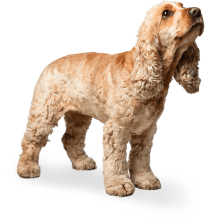

Stiff joints in dogs: Why your dog's joints hurt & caring for them
If your faithful friend is struggling to get up the stairs, is slowing down on walks, or isn’t as playful as they used to be, it might be time to take a closer look at their joints.
Stiff joints in dogs are common, especially as they age, and can affect everything from their movement to their mood. You might notice they’re sleeping more or hesitating to jump or run. Don’t worry — there are plenty of ways to help ease their discomfort, from simple adjustments to their routine to exploring how to treat dog stiff joints.
Read on for expert tips and advice to keep your pup happy and active.
Symptoms of stiff joints in dogs include:
Stiff joints can show up in a variety of ways. Knowing what to look for is the first step in helping your dog feel better.
Your dog is having difficulty standing, sitting, or lying down
Does your dog hesitate when settling down or seem to struggle to get up? These moments can be early signs of stiff joints. If you spot these behaviours, the first step is to speak to your vet, so they can help you find out the cause. You can also help make their life more comfortable with aids for senior dogs, such as memory foam beds, non-slip rugs and steps or ramps.
Your dog seems slow or stiff when getting up
If you’ve noticed your pup taking longer to rise, especially after lying down for an extended time or changing position regularly once settled, it can point to stiff hind legs or sore joints. Regular, gentle exercise and short, consistent walks can help improve their mobility and keep them moving comfortably.
Your dog has trouble climbing stairs
Stairs can be daunting for dogs with joint issues. If your dog avoids the staircase or moves cautiously with each step, it’s likely because their joints are stiff or hurt. Proving ramps or limiting their need to climb can make a big difference in their day-to-day comfort.

Your dog is reluctant to jump or run
Is your dog skipping their usual jump onto the sofa or staying put when it’s time for a run? Reluctance in these activities is often a telltale sign that their joints are causing discomfort. It’s important to encourage activity in a way that won’t strain their joints further, such as low-impact play.
Your dog has decreased activity
Dogs are naturally lively, but if your buddy seems less eager for walks or playtime, it could be down to sore joints. You might notice them lagging on walks or taking longer to catch up. Always keep an eye on their energy levels — subtle changes can tell you a lot. Speak to your vet if you’re worried.
Your dog is limping or holding a limb up
A noticeable limp or reluctance to put weight on certain legs can indicate they’re trying to alleviate pain. Keep an eye on their movements and book a vet appointment if this persists, as it could be a sign of inflammation or injury.
Dog sleeping more
Dogs certainly have their dozy times – especially after a long walk or a race around the park with friends. But if you’ve noticed your dog is much sleepier than usual, it could be a sign that their joints are stiff. Talk to your vet who can help you get to the bottom of this.
- Older dogs often sleep more – this shouldn’t be a surprise to anyone who nods off in front of the telly. The older we get, the more we sleep, and your dog can be the same. Whilst it’s usual for senior dogs to rest, oversleeping can be a sign your dog is retreating into themselves, and this can be because they feel stiff.
- A comfortable bed is important – a specialist bed will help to support their joints, giving them a more comfortable rest, so choosing an orthopaedic bed will help.
Dog walks taking longer
Without looking like they’re stiff, your dog could be gradually slowing down on your daily walkies. You might notice that they’re taking longer than usual to do your standard walk or that you have to stop and wait more often while they catch up. This could be a sign that it’s becoming difficult for them to walk quickly. If you notice this, we recommend you make an appointment with your vet to get your pup checked out.

Your dog’s joints look swollen
Swollen joints are a visible clue something isn’t right. If you spot unusual puffiness or tenderness when touching their joints, consult your vet for guidance. Early treatment can help manage conditions like arthritis in dogs more effectively.
Changes in behaviour
Not all signs are physical. If your dog seems grumpy, withdrawn, or reluctant to be touched, they might be reacting to pain. A small behavioural shift can sometimes signal a bigger issue, so keep an eye on their mood.
Stiff joints in dogs can be caused by a number of things including:
Arthritis
Arthritis is a common culprit for stiff joints in dogs. It occurs when the cartilage between joints deteriorates, causing pain and stiffness. Canine arthritis is more prevalent in older dogs, but it can affect pups of all ages. Regular check-ups and early intervention can help manage this condition.
Excess weight
Carrying extra weight doesn’t just slow your dog down — it also puts pressure on their joints. Over time, this stress can lead to stiff joints and discomfort. If your dog is overweight, introducing a tailored diet and steady weight loss plan can protect their joints and help improve their quality of life. Your vet will be able to support you and your pup on their weight loss journey.
Trauma or injury
Did your pup take a tumble or overdo it on their latest adventure? Injuries like sprains and strains can cause stiffness, while more severe trauma might cause lasting joint issues. A vet check-up is crucial to ensure a quick recovery.
Hip dysplasia
This hereditary condition involves the misalignment of the hip joint and can cause stiffness, pain and lameness lameness, and cause osteoarthritis over time. Large breeds are particularly prone to hip dysplasia. If you suspect your dog may have this condition, your vet can offer tailored advice. Learn more about dog breeds with joint problems.
How to treat a dog’s stiff joints
There’s good news — while stiff joints in dogs can be tough, there are many ways to help ease their discomfort.
Medication from your vet
Seeing your vet is the first step in determining how to treat your dog’s stiff joints. They might suggest anti-inflammatory medications or pain relief tailored to your dog’s needs. Always follow their advice for the best results.
Make adaptations to your home
Small changes can make a world of difference. Think about ramps for ease of movement, an orthopaedic bed for joint support, or even non-slip flooring to prevent falls. You can explore practical solutions with our guide to aids for senior dogs.
Adjust your walks
While staying active is important, overdoing it can worsen joint pain. Shorter, gentler walks on soft terrain are ideal for dogs with sore joints. It’s about finding the right balance of activity to keep them moving comfortably without adding stress.
Consider dog joint supplements
Joint supplements for dogs can also be a great support to dogs with stiff joints. They can take a number of weeks to be fully effective, so a proactive approach is recommended.
By understanding the symptoms of stiff joints in dogs and taking steps to support their needs, you can help your beloved pet live their best life—tail wags and all!



